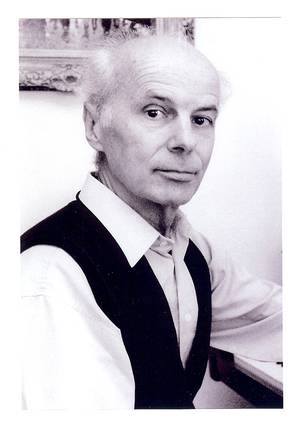CD Marcus Weiss
Game spaces between heaven and hell
From January 26 to 29, Basel festival “SPIEL! Games as critical practice” explores the critical potential of playing. Composer Michel Roth curated the festival.
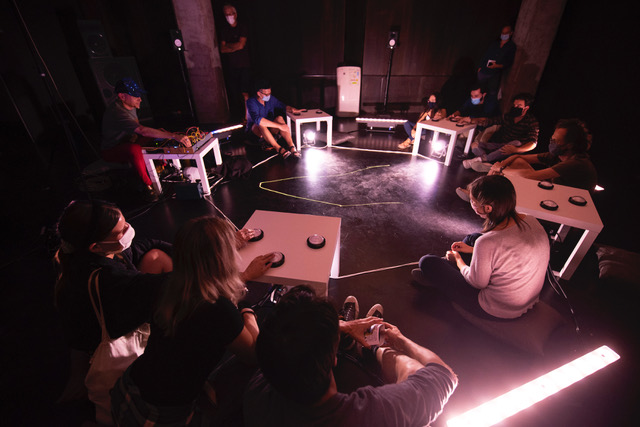
Friederike Kenneweg
Anyone who happens to talk to Michel Roth about playing can’t help discovering that it’s not just one single subject, but a multidimensional thematic field that opens up. For one can play with very different things: words, things, thoughts, sounds, colours or instruments… A game sets rules and creates its own world for its duration, whether it is music, a computer game, role-playing game or a board game. Those who see themselves as players in such a world look for rules to play by and each player has the possibility to influence the game within the space given to him or her, but the rules by which a game is played can also be changed – revealing a sudden philosophical or political dimension. It is true that playing can serve as an escape from the world and lead to a certain escapism. But it can also develop a critical, even world-changing potential.
Mary Flanagan’s “Critical Play”
Michel Roth found this idea formulated particularly succinctly in the writings of American game designer Mary Flanagan, which he came across during his research on games and play. He was particularly impressed by Flanagan’s 2009 book “Critical Play. Radical Game Design”, in which she emphasises the critical potential that can lie in the setting of games from the designer’s point of view. Which images, clichés and ideas should be reproduced, which ones should be changed? In what realm of possibilities should the players stay during the game? How games are designed can also influence real life and how we see it and perhaps even: what we want to change in it.
Hopscotch
Mary Flanagan will be a keynote speaker at the festival in Basel. and also present her mapscotch project in Theater Basel’s foyer. The project is based on the chalk drawing and playground game “Hopscotch”. Visitors can define their personal squares and the foyer’s floor becomes an individual hopping playground during the entire festival.
Sound and structure of the pinball machine
Another phenomenon that has long fascinated Michel Roth is slot machines. For ZeitRäume Basel in 2021, he designed a “game hell” in which the soundscape of pinball machines significantly determined the sound.
No wonder that such machines will also make a guest appearance at the festival. The former Theater Basel ticket office will host pinball machines and other games for the audience to try out (and listen to). In a lecture performance in collaboration with double bass player Aleksander Gabrys, Michel Roth will deal with the pinball game once again under the title Pinball Etudes, but this time by transforming a double bass into a pinball machine and preparing the strings with movable balls. Normal instrumental playing is no longer possible, but action and sound now also depend on where the balls roll. What exactly will happen can neither be composed nor rehearsed.
In the piece Räuber-Fragmente after Robert Walser, Michel Roth applied game theory to a composition for the first time, putting Walser’s novel Räuber into a kind of play configuration. A free improviser is on stage and free to intervene in the play whenever he or she feels like doing so, like a kind of spoilsport.
Play and composition
The festival also presents a variety of works by composers who have explored the game subject from different points of view. For example, Bernhard Lang has been working on a series of works entitled Game since 2016, in which the instrumentalists are given a playing space defined by a fixed set of rules, which they can then use freely. GAME 3-4-3 and Game ONE by Bernhard Lang will be featured in Basel. In Homo Ludens (2019), Mike Svoboda offers the players a choice of five settings, each of which with its own set of rules, while in her percussion piece Poker, Roulette (2020), Sarah Nemtsov explores the contrast between gambling instinct and gambling addiction – two principles that seem very close to each other and yet involve completely different energies.
Mike Svoboda’s Homo Ludens divides the musicians into two teams. Do they also compete against each other while making music? Recording from the first night of the piece, Gare du Nord, March 2019, played by Camerata Variabili and Mike Svoboda und Lucas Niggli as guest musicians.
Contrast, clash, encounter
Michel Roth consciously decided not to limit the thematic width that goes hand in hand with the festival theme, but to let approaches from game design, musicology, performance art, composition and pedagogy collide against or with each other. He is particularly curious to see whether the different target groups will relate to other areas. Will the gamers perhaps become hooked to new music? Will everyone play Mapscotch together in the foyer? Will visitors also meet completely uninvolved people at the Real World Audio Game on Theaterplatz? Will they all participate together in the Jeu sonore, to which Sébastien Roux and Clément Canonne invite the audience?
The festival itself becomes a space of possibility that invites the audience to play and make decisions in many different ways. Whoever gets involved in this mixture of lectures, concerts, installations and interactions can experience something intellectually, sensually and playfully – depending on where the pinball rolls.
Friederike Kenneweg
Festival “Spiel! Games as critical practice” from 26th to 29th of January 2023, in the Foyer Theater Basel, Musikakademie and Jazzcampus.
Bernhard Lang, Sarah Nemtsov, Sébastien Roux, Clément Canonne, Marko Ciciliani, Mary Flanagan, Critical Play: Radical Game Design,
Broadcast SRF Kultur:
neoblogpost 2.9.2021: Infinite game worlds, Auhtor: Jaronas Scheurer über about “Spiel Hölle”, project by Michel Roth
neo-profile:
Michel Roth, Mike Svoboda, Aleksander Gabrys, sonic space basel
“In maletg da mia veta”
Gion Antoni Derungs (1935-2012) is not only Graubünden’s most prominent composer. He is also considered one of Switzerland’s outstanding musical personalities. Ten years after his death, he is receiving an extensive tribute through a biography and a Derungs Festival was held in Chur.
Portrait by Laura Decurtins.
Laura Decurtins
The wide-ranging works of Gion Antoni Derungs reflect artistic imagination, strong musical identity and an irrepressible creative urge; he himself described them as the “image of his life”. In his productive engagement with the local musical traditions as well as with the international musical currents of the 20th and 21st centuries, Derungs achieved an unmistakable personal style. Today, his name stands for high-quality musical works of art that range from simple songs to complex instrumental works, speaking to amateurs and professional musicians alike.
Portrait Gion Antoni Derungs zVg. Fundaziun Gion Antoni Derungs
Folk Songs as “Roots” and “Source”
Gion Antoni Derungs was born on September 6, 1935 in the small village of Vella in the Val Lumnezia. After his father’s premature death, the family had to make ends meet with hardly any means, but the highly talented mother – sister of the famous musician Duri Sialm – nevertheless attached great importance to the musical education of her children. Romantic piano music, operas and the folk songs of Surselva surrounded Derungs from an early age. Furthermore, he was sometimes allowed to accompany church services on the harmonium, so that he also became familiar with the old Catholic hymns of the Surselva. The “canzun romontscha” became both a musical identity root as well as a source for Derungs’ compositions.
From piano student to musical director
In 1949 Derungs entered the grammar school of Disentis abbey and was taught piano and organ by village music teacher Giusep Huonder as well as by his uncle Duri Sialm. After graduating from high school, he was offered to study at the conservatory in Zurich, where – in addition to piano – he took composition, music theory, organ, conducting and score playing lessons; while at the same time studying school singing at the music academy. In 1960, while still in his studies, he was appointed musical director in Lichtensteig (Toggenburg) as his uncle’s successor and in 1962 he was finally appointed piano and organ teacher at Chur’s Bündner Lehrerseminar, as well as organist and director of the Romansh city choirs Alpina and Rezia.
Guinea pigs and “house interpreters”
In 1968, together with Pastor Gieri Cadruvi, Derungs founded the record series “Canzuns popularas” (CPLP) to promote Romansh songs. Until 1987, 13 recordings were released with a wide variety of programmes and performers. The main interpreter was the Ensemble Quartet grischun, an elite chamber choir founded by Derungs himself and with whom he was able to try out his latest, avant-garde vocal creations, such as the Missa pro defunctis op. 57, for which he won the gold medal at the international composition competition in Ibagué (Colombia).
Gion Antoni Derungs, Quintett op 25 für Flöte, Klarinette, Violine, Violoncello und Klavier, in house-production SRG/SSR
Derungs’ colleagues at the teacher seminar, including his cousin, organist Esther Sialm, became the actual “house interpreters” of his instrumental chamber music. Between 1969 and 1971, Radio Rumantsch offered Derungs’ so-called “musica moderna” a platform – which promptly earned him an ambiguous “modernist” reputation. The works presented included the Quintet op. 25 for flute, clarinet, violin, cello and piano, a “symbiotic” combination of linear-polyphonic moments with cluster sounds and noise explosions, as well as the Silhouettes op. 17b for clarinet and piano, where silhouette-like contours increasingly emerge from an initial “jumble of lines and dots”.
Gion Antoni Derungs, Silhouetten op. 17b für Klarinette und Klavier, in house-production SRG/SSR
From the avant-garde back to tonality
Derungs composed such “musica moderna” from 1968 to the mid-1970s. Even as a student, he was fascinated by the experiments of the post-war musical avant-garde, serialism, aleatoric and minimal music, but also by the Polish School of the 1960s with its sound surface and timbre music. However, he kept his distance from the Darmstadt circles and their Summer Courses for New Music, which were setting the tone at the time.
In the mid-1970s, Derungs turned to the “simpler”, neo-tonal music of postmodernism, but without wanting to join the relevant circles. He always used the musical languages of his century very freely and undogmatically, whereby everything had to have its justification. Derungs saw “hopeful perspectives” for the further development of his personal style in the regained tonality. However, since he never sought instant success, many works waited decades “in the drawer” for a first performance.
“Looking ahead”: breakthrough and success
Derungs achieved his breakthrough in Graubünden with a vocal work written during this period: the opera-ballet Sontga Margriata op. 78. In his perception, returning to tonality also meant getting back to his musical roots: “Preserving tradition means looking forward”, and the folk songs allowed him to create contemporary music with a native tone. From what is probably the oldest Romansh song, La canzun da Sontga Margriata, he created a contemporary work that enjoyed a successful premiere in 1981 through a Graubünden-Geneva collaboration. This nationwide success motivated him to use the Romansh language also for genres that had no tradition in Graubünden: the art song on the one hand, but above all: the grand opera, which he “invented” in 1984 with Il cerchel magic op. 101. The work received a positive response also abroad – but in Romansh-speaking Graubünden, this first “opera rumantscha” has since been regarded as a musical milestone.
Gion Antoni Derungs, Il cerchel magic (der magische Kreis), 1984, in house-production SRG/SSR
Over the years, Derungs composed a large number of instrumental works: from small-scale chamber music and solo concertos to large symphonies – all of which he composed on his own initiative. Over the years, however, he also received commissions from a wide variety of formations at home and abroad, for which he created works tailored to the performers in the shortest possible time. Furthermore, Derungs also set a crime story, a fairy tale and the dramatic life of Red Cross founder Henry Dunant to music; his later work were three sacred vocal operas for the Origen Festival in Surses, based on multilingual libretti by its director Giovanni Netzer. The works are based on a mixture of free-tonal harmonies, impressionistic colours, motet-like techniques and a strong word-sound relationship.
“Everyone must step down at some point”
This tonal language showed its maturity in his last a cappella choral work, the Nachtgebet Complet op. 189, which Derungs completed in 2011. In that year he was diagnosed with cancer and suddenly had to get used to the idea of imminent death. In fact, death had accompanied him since childhood and over the years it also found its way into various compositions, connecting them to a certain extent thematically, for example the Requiem op. 74 with the 2nd Symphony op. 110, the Mourning Symphony, or the Sontga Margriata with the 8th Symphony «Sein-Vergehen» (“To Be – To Pass Away”). “Everyone must step down at some point,” Derungs noted about his 8th Symphony. “And we are all aware of this.”
Gion Antoni Derungs, Sinfonie Nr.8, op. 158 (2002/2003), in house-production SRG/SSR
Gion Antoni Derungs died on September 4, 2012, two days before his 77th birthday. He left a huge oeuvre with 191 opus works and hundreds of compositions without opus numbers. As early as 1996, he was awarded the honorary title of «Orpheus der Rätoromanen» (“Orpheus of the Rhaetians”), an artist who transcends borders and transfers the local musical tradition into art. However, the highest honour that can be received by a Graubünden citizen was to follow posthumously: in 2015 Derungs was chosen by the Romansh media as “in dils nos” (one of ours).
He never denied his Romansh roots and always considered the “little wishes” of his homeland.
Laura Decurtins
Laura Decurtins is the author of the new biography on Gion Antoni Derungs, published by Chronos in the fall of 2022.
The Chur Gion Antoni Derungs Festival took place from September 1 to 4, 20220, among other places at the Theater Chur, and was mainly performed by the ensemble ö! The concerts were recorded in total on video by RTR and are available on neo.mx3.
Gion Antoni Derungs / Fundaziun
Duri Sialm, Giusep Huonder, Gieri Cadruvi, Quartet grischun, Esther Sialm, Giovanni Netzer, Henry Dunant
radio features SRF 2 Kultur:
Neue Musik im Konzert, 14.12.22: Gion Antoni Derungs-Festival in Chur, author Cécile Olshausen
neo-profiles:
Gion Antoni Derungs, Ensemble ö!
Communiquer au-delà de la musique
Eric Gaudibert, pianist, composer and lecturer from Geneva has been a key figure in the contemporary and experimental music scene of French-speaking Switzerland. Deceased ten years ago, he influenced a whole generation of musicians as teacher and promoted important ensembles for contemporary music. From December 9 to 17, they will jointly organise a tribute festival and concert marathon in Geneva’s Victoria Hall, which will include the premiere of 22 miniatures composed by his former students.
Gabrielle Weber
They are called Contrechamps, Ensemble Vortex, Eklekto Geneva Percussion Center or Nouvel Ensemble Contemporain (NEC) and have two things in common, they are very active in the contemporary music scene of French-speaking Switzerland and they all have a strong connection to Eric Gaudibert.
Daniel Zea, Serge Vuille and Antoine François, artistic directors of Vortex, Contrechamps and NEC, initiated the festival as a collaborative project: “the idea came up spontaneously, talking about Eric and tackling it together came very naturally,” says Daniel Zea, because Gaudibert has been important for the development of the whole scene. The Haute école de musique Genève (HEMG) will host a conference, a film screening with table ronde, and a concert by Vortex, followed by the concert marathon with the HEMG orchestra at Victoria Hall.
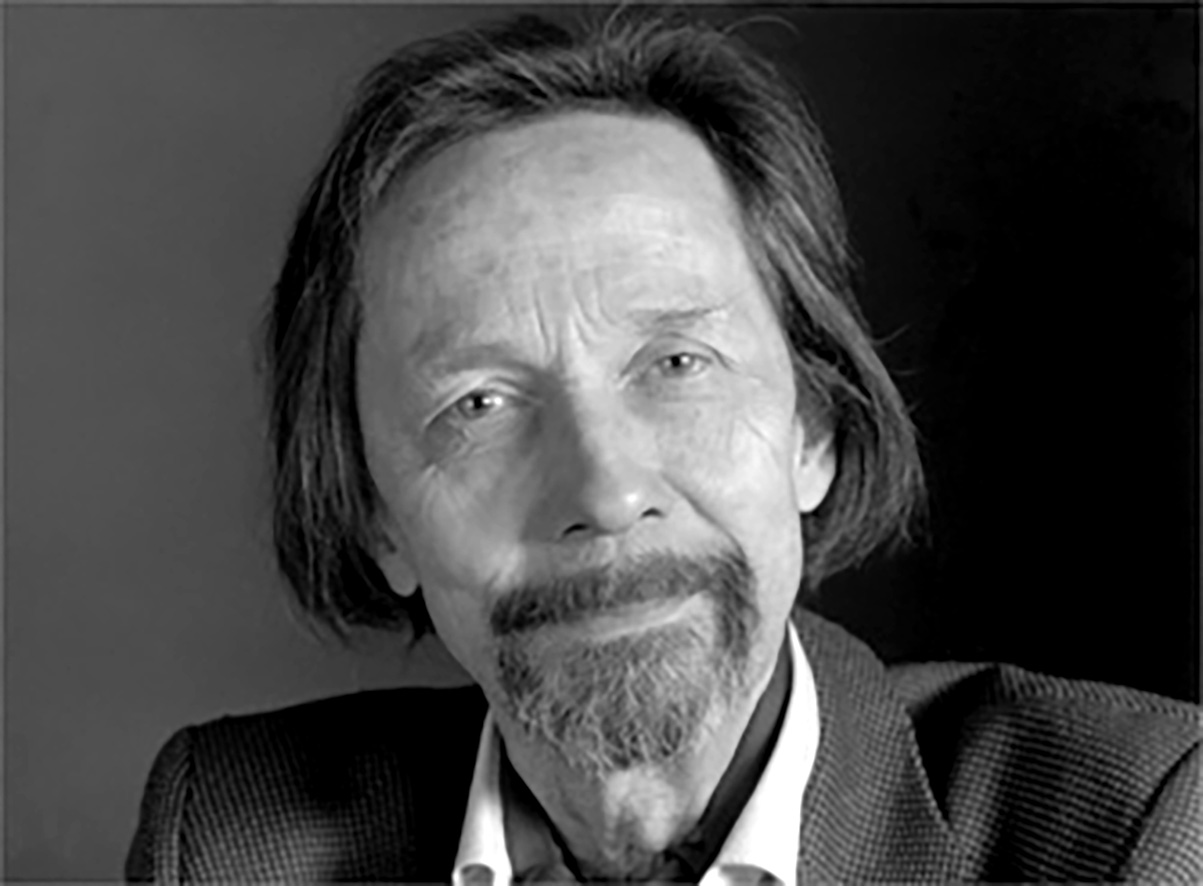
Gaudibert described his urge to teach as “communiquer au-delà de la musique”, communicating beyond music. He first experienced this communication in France, where, he worked from 1962 in the fields of “animation” as well as music transmission, in rural regions, after studying piano in Lausanne and composition in Paris. After returning to Switzerland, he taught composition for many years at the Conservatoire Populaire de Genève and then at HEMG. Michael Jarrell and Xavier Dayer, both renowned composers and teachers with roots in Geneva, were his students and he accompanied many other national and international careers as an artistic guiding figure, promoter and networker.
Serge Vuille, director of Contrechamps, did not study with Gaudibert directly, but was still impressed by the “Gaudibert phenomenon” and its lasting presence in the scene, also demonstrated by how quickly other partners agreed to participate in the festival. Contrechamps works constantly with Gaudibert’s former students, be they interpreters or composers. “That’s why I wanted to show this teacher-pupil aspect and its two sides at the festival,” says Vuille.
On one hand, there is Nadia Boulanger, Gaudibert’s theory teacher in Paris: Contrechamps will perform one of her orchestral works. She taught many composers who are now performed all over the world, but her own works are rarely performed. According to Vuille, she is overlooked as composer because she is mainly perceived as a teacher.
On the other hand, Contrechamps commissioned Gaudibert’s former students with short compositions. Considering the high number of 45 graduates, “only” a regionally manageable circle of those still working in or connected with French-speaking Switzerland were asked and, with two exceptions, all of them accepted. “The strong commitment by his students was very impressive,” says Serge Vuille.
Guidelines were a duration of only one minute, but open instrumentation, from large ensemble to solo and even tape, 22 miniatures will now be performed, including works by Arturo Corrales, Fernando Garnero, Dragos Tara or Daniel Zea.
Daniel Zea highlights another aspect of the teacher-pupil communication: “We are all very grateful for what he gave us and what he made possible. At the same time, it was a game of give and take: Eric was open and curious – he was interested in what we were interested in. We influenced him, for example, with traditional music from our countries.” Zea, like some of the graduates of Gaudibert’s composition class, comes from South America. His ensemble Vortex came together in Gaudibert’s classes and was accompanied and supported by him until the end.
Hekayât, pour rubâb, hautbois, hautbois baryton, alto et percussion, 2013, in house-production SRG/SSR, performed by Khaled Arman on the rubâb, an Arabic lute, is one of Gaudibert’s late works, in which he seeks to integrate instruments, their performers, and modes of play from other cultural spaces.
Electroacoustics and diversity
Gaudibert, born in Vevey in 1936, studied in Paris with Nadia Boulanger and Henry Dutilleux. He is best known for his poetic and visual instrumental works, but there are also other, lesser-known sides: Back in Switzerland, he researched electronic sounds during the early seventies in his self-described “experimental” phase at Lausanne’s radio experimental studio.
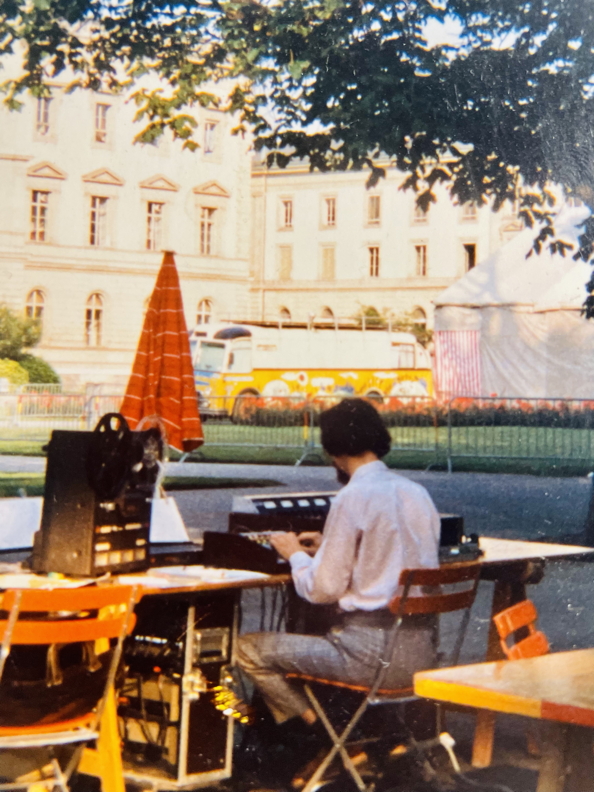
Vortex’s concert of December 10 is entirely dedicated to his electroacoustic works, which is consistent with the ensemble’s multimedia orientation: “it’s an important phase of his work that is rarely revealed,” says Daniel Zea. Together with John Menoud, composer and multi-instrumentalist, he visited Gaudibert’s widow Jacqueline and together they went through many videos, audio cassettes and scores. Pieces for instruments and tape or live electronics, often performed only once or twice, will be performed by musicians who worked closely with Gaudibert. Benoît Moreau, for example, who will play En filigrane for epinette (spinet) and tape, which was performed only once, by Gaudibert himself, at the premiere 20018 – with Moreau present.
The choice of repertoire for the final concert shows Gaudibert’s versatility. “We decided to combine key works such as Gong – his last major ensemble work – with rarely performed pieces to show the diversity of his oeuvre,” says Vuille. Gong is dedicated to pianist Antoine Françoise, who will also interpret it at the festival, together with Contrechamps. François, now an internationally sought-after solo pianist and director of the NEC, also had a close relationship with Gaudibert, who, pianist himself, accompanied and supported François’ development from their first meeting when he was 16 years and relied on his skills for Gong’s demanding part when he was only 24.
Gong &Lémanic moderne ensemble, in house-production SRG/SSR
In addition to his instrumental works, Gaudibert’s electroacoustic phase will also be represented at Victoria Hall: Vortex performs Ecritures from 1975 for one voice and tape, created in Lausanne’s Experimental Studio, in a new version for four voices distributed in the room. “The piece lives on with new technical possibilities, which would have been in Gaudibert’s spirit,” says Zea. Eric Gaudibert would certainly have welcomed the fact that his former students continue to work together – in communication beyond music.
Gabrielle Weber
Nadia Boulanger, Henri Dutilleux
“Eric Gaudibert, pianiste, compositeur, enseignant”. Film Plans fixes, 48mn, Suisse, 2005 : In this 2005 film portrait, Gaudibert talks about his most beloved themes, such as his fondness for literature and painting, his times in Paris, teaching and the influences of other cultures on his musical work: the film is the focus of a panel at Geneva Festival Gaudibert on December 10.
9/10 décembre 2022, HEMG : Congrès / Concerts : Composers and lecturers Xavier Dayer, Nicolas Bolens and ethnomusicologist as well as interpreter Khaled Arman, among others, will discuss the portrait at HEMG.
17 décembre 2022, Victoria Hall Genève, 18:30h : Concert marathon Contrechamps, Eklekto, le NEC, Vortex, orchestre de la HEMG, chef d’orchestre : Vimbayi Kaziboni, Gaudibert, Boulanger, UA 22 miniatures
Features RTS:
musique d’avenir, 6.2.2023: Festival Gaudibert 2022, author: Anne Gillot
Neo-Profils
Eric Gaudibert, Daniel Zea, Antoine Françoise, Arturo Corrales, Fernando Garnero, Dragos Tara, Ensemble Vortex, Contrechamps, Nouvel Ensemble Contemporain, Eklekto Geneva Percussion Center, John Menoud, Benoit Moreau, Ensemble Batida, Xavier Dayer, Michael Jarrell
Sonic Matter: what matters is the sound
Sonic Matter – Festival for Experimental Music takes place for the second time this year from 1 to 4 December in Zurich. Under the multi-literal motto Rise, the festival points beyond itself. One focus being on music creation in sub-Saharan Africa.
Friedemann Dupelius
“It matters what matters we use to think other matters with”, writes philosopher Donna Haraway. The Zurich festival Sonic Matter understands sound as something that matters. With sound and music, we can think about things that transcend it. Sound can be a gateway to the world, listening a way of reflecting and engaging with our environment. In the second edition of the festival, which succeeded the Zürcher Tage für Neue Musik in 2021, this perspective becomes apparent.
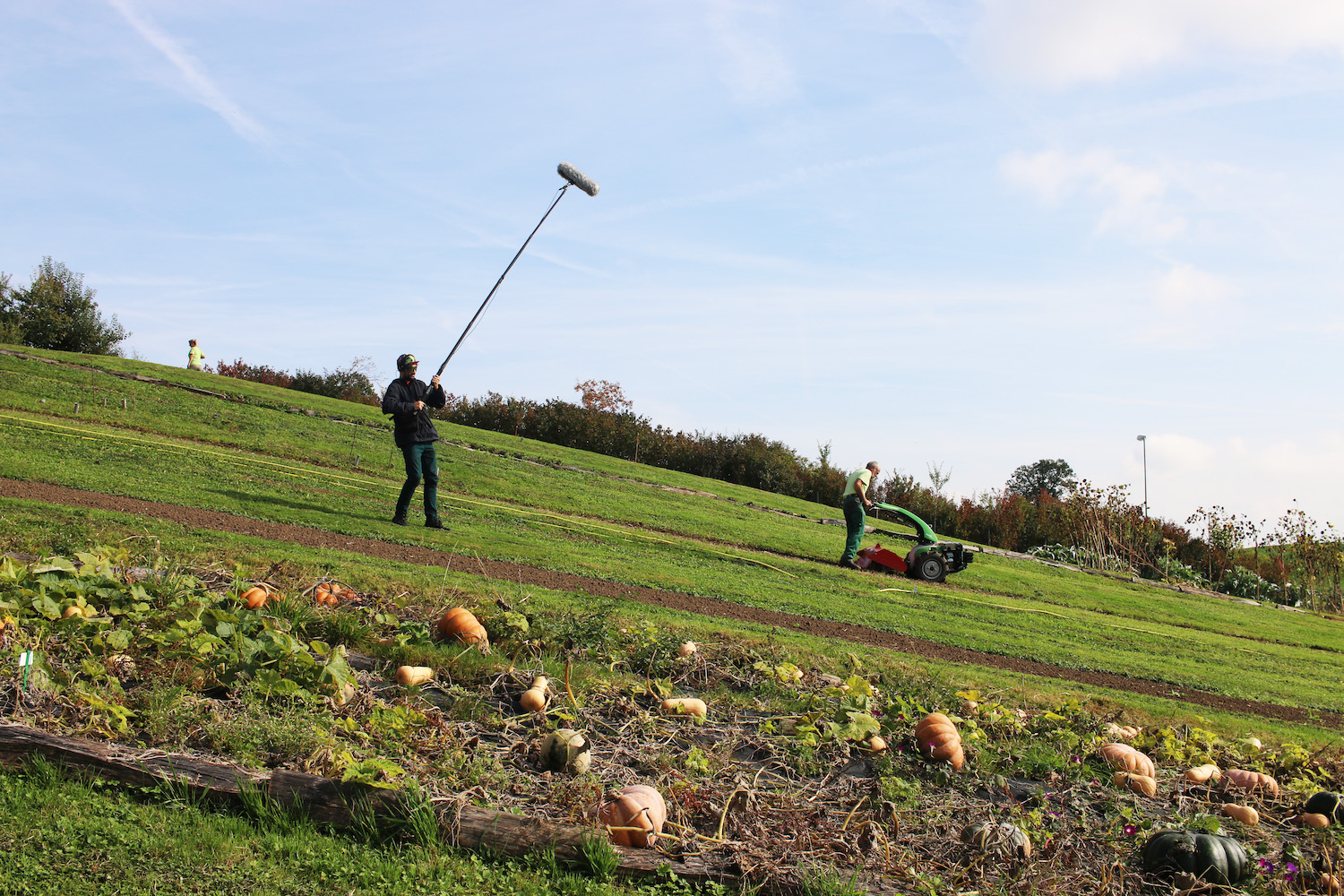
With “Rise”, the middle word of the motto triad Turn – Rise – Leap now provides the guiding thought impulse: “This can be understood in the sense of growing or emerging – or also as something resistant, rebellious, that aims at expanding boundaries,” Lisa Nolte explains. She, too, is part of a triad. Together with composer Katharina Rosenberger and artist and curator Julie Beauvais, they form of the core team behind Sonic Matter since its conception in 2021. The subtitle “Platform for Experimental Music” makes two things clear: Sonic Matter thinks beyond the boundaries of a festival. It is not over after four dense days, but sees itself as an ongoing process. In addition, the term “experimental” signals aesthetic breadth. According to Lisa Nolte, the aim is “to have as much scope as possible for sound-based current art forms”. On the one hand, there are formats with contemporary music as it has established itself in Europe – with for example, the Tonhalle Orchestra performing music by Peter Ruzicka and George Enescu, or Collegium Novum Zurich playing Iannis Xenakis’ Φλέγρα (Phlegra) alongside a world premiere by Laure M. Hiendl. But Lisa Nolte adds: “New music is often about a very specific idea of quality, which is not to be found everywhere. Other approaches can be very stimulating.”
Iannis Xenakis – Φλέγρα (Phlegra) (1975), played by Ensemble Phoenix Basel
Listening, thinking and dreaming with archives
These approaches can come from other forms of music and art, or even from places in the world that have long received too little attention. The duo Listening at Pungwe from South Africa and Zimbabwe, for example, has a very unique artistic approach to sound. Memory Biwa and Robert Machiri collect music and field recordings from their home regions. They understand this material as a sound archive whose contents they put in a new context during their performances and listening sessions. The eponymous term “Pungwe” is reminiscent of the ritual of a wake, during which those who attend are in a particularly alert state – a state that also makes it possible to dream of a better future or to motivate oneself for uprising.
A Live-Session by Listening at Pungwe in Kapstadt 2017
Sound and music archives are indeed such a “Matter” with which other “Matters”, like things or topics can be thought about. Collected sound recordings contain information about history, social and political circumstances and much more, offering the possibility of imagining and dreaming about how the world could be. In this sense, the students in the Once Upon A Sound project with Roman Bruderer, Peter Nussbaumer and Iva Sanjek have created their own sound archives, which they will present at the festival during dedicated listening sessions and DJ sets.
The people of all ages who worked with artists Léo Collin and Manon Fantini also sharpened their ears to the sounds of their surroundings, resulting in the installation Play The Village. In the joint listening sessions with the cozy title Soft Pillows – Hot Ears, the focus is also on listening together. Moroccan artist Abdellah M. Hassak will present an entire symphony of archives in the Walcheturm art space.
Noémi Büchi plays “live from the Listening Lounge” (3.12.) at Kunstraum Walcheturm
Another focus of Sonic Matter 2022 is the sub-Saharan region of Africa. In addition to Pungwe, artists from the Ugandan music festival and label Nyege Nyege will be in Zurich. Label founder Rey Sapienz, for example, will be DJing at the party in the Gessnerallee, stating what Lisa Nolte already knows: “Listening is an active procedure, which also becomes apparent when music puts you directly into physical movement.” Dancing is also Sonic Matter – a sonic experience and the moment when sound becomes embodied matter. Latefa Wiersch, Rhoda Davids Abel and Dandara Modesto tell of dreams and longings for the lost African homeland in their interdisciplinary performance Neon Bush Girl Society, exploring legends of the fled ethnic groups Nama and Damara from southern Africa.
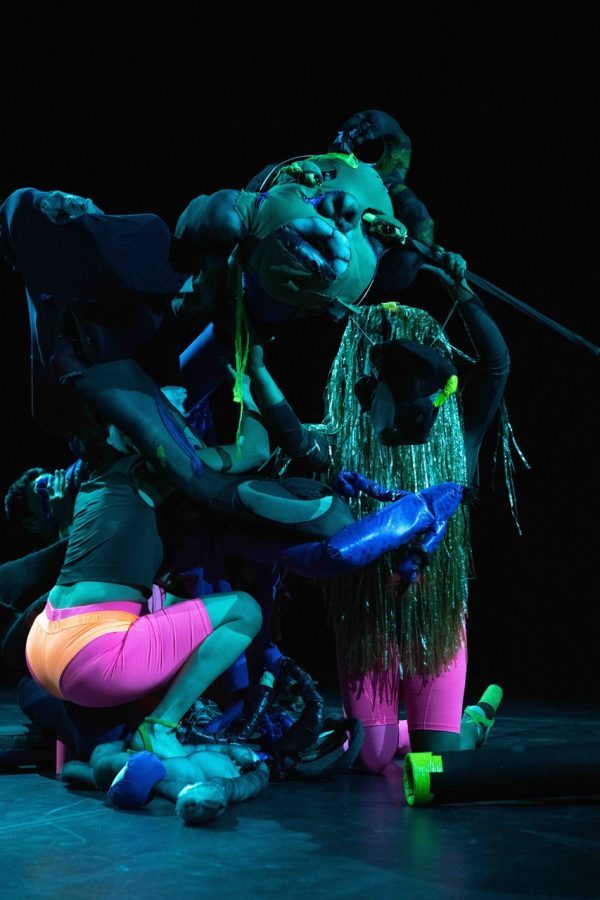
Sonic Matter is always
Sub-Saharan Africa 2022 is prominently featured also in the Open Lab. With this permanent format, Sonic Matter emphasises that it takes place 365 days a year. At the Open Lab, experts from various fields, like arts, science and civil society work together on urgent issues in their respective regions of the world. The individual projects deal with indigenous peoples in Uganda and Mozambique, the cultural and political life of South Sudanese refugees in Kenya or historical sounds in Johannesburg. The online platform is continuously updated. Another project that keeps the sound and thought processes going around the clock is Sonic Matter Radio, as Sonic Matter is not only four exciting days of music, sound and art in Zurich – it is also a permanent state of listening, thinking and narrating around the globe. According to Donna Haraway, narratives create the world: “It matters what stories make worlds, what worlds make stories”.
Friedemann Dupelius
Sonic Matter: 1.-4.12.2022 in Zürich
Sonic Matter Radio, Sonic Matter Open Lab
Partner festival 2022:
Nyege Nyege (Uganda)
SRF 2 Kultur:
Sonic Matter 2021 at neoblog @neo.mx3
SRF report on Sonic Matter 2021
Donna Haraway, Roman Bruderer, Laure M. Hiendl, Latéfa Wiersch, Manon Fantini, Rey Sapienz, Listening at Pungwe
neo profiles:
Sonic Matter, Katharina Rosenberger; Iannis Xenakis; Léo Collin; Collegium Novum, Tonhalle-Orchester Zürich, Olga Kokcharova, Noémi Büchi
Lucerne Festival Forward comes to “a clean end”
Jaronas Scheurer
The Lucerne Festival Forward has taken place in Lucerne from November 18 to 20, 2022. Alongside big international names such as Anna Thorvaldsdottir, Patricia Kopatchinskaja and Tito Muñoz, the programme also included the collective intervention A Clean End to end the festival.
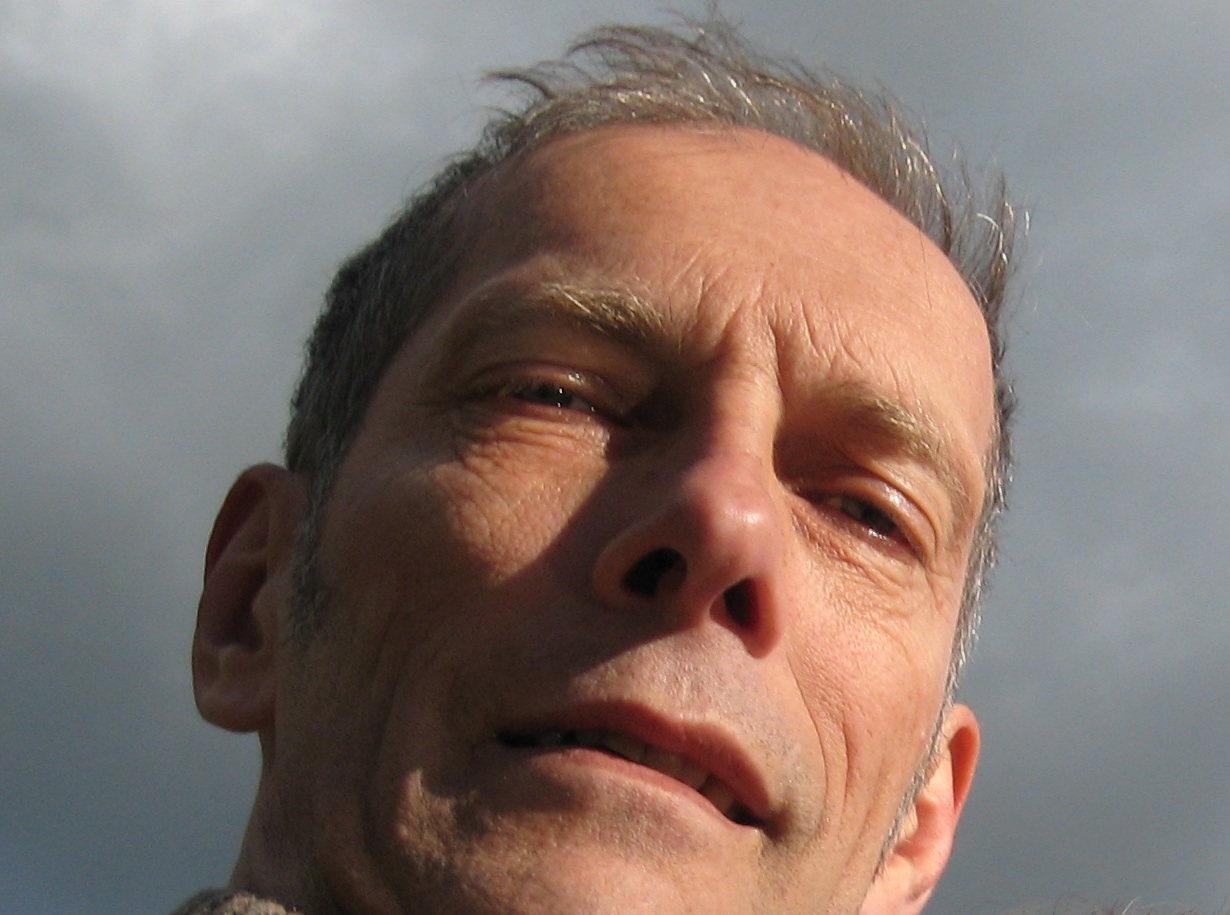
During an interview, Lucerne composer and musician Urban Mäder described himself as an expert on all kinds of cleaning machines – and there is a good reason for that. Because for the closing of this year’s Lucerne Festival Forward (LFF), for once it is not the musicians of the Lucerne Festival Contemporary Orchestra (LFCO) who are in the spotlight, but, among others, KKL’s cleaning staff and their various types of hoovers, mops and cleaning machines.
Urban Mäder and Peter Allamand: sound installation ‘Balgerei’ at the festival Alpentöne, Altdorf 2015.
Researching at 6 o’clock in the morning
After LFF’s first edition last year and the performance of Ricefall by Michael Pisaro by 49 amatuers, another participative action took place this year: A Clean End. The action is called a collective intervention and its driving forces are Urban Mäder, Nora Vetter, Pia Matthes and Peter Allamand. The intervention took place as closing event of the last concert.
But what is there to do at the end of a festival or a concert? Well, cleaning, so that the whole thing has “a clean end”. This was the premise on which the four artists based their work and dealt intensively with the used cleaning equipment. After every KKL concert, a fifteen people strong cleaning team from Vebego arrives at 6 AM on the following morning and cleans each and every corner of the place, concert hall, foyer, toilets and the numerous rooms. They do not use buckets and brooms, however, but various ultra-modern cleaning machines, which Mäder, Vetter, Matthes and Allamand studied intensively, examining exactly the different sounds they could generate, as Urban Mäder reports. They even went to the KKL at 6 o’clock in the morning to watch the Vebego team at work. Their research and work eventually gave birth to a composition for a group of amateurs who responded to a call from LFF to become the actual A Clean End performers.
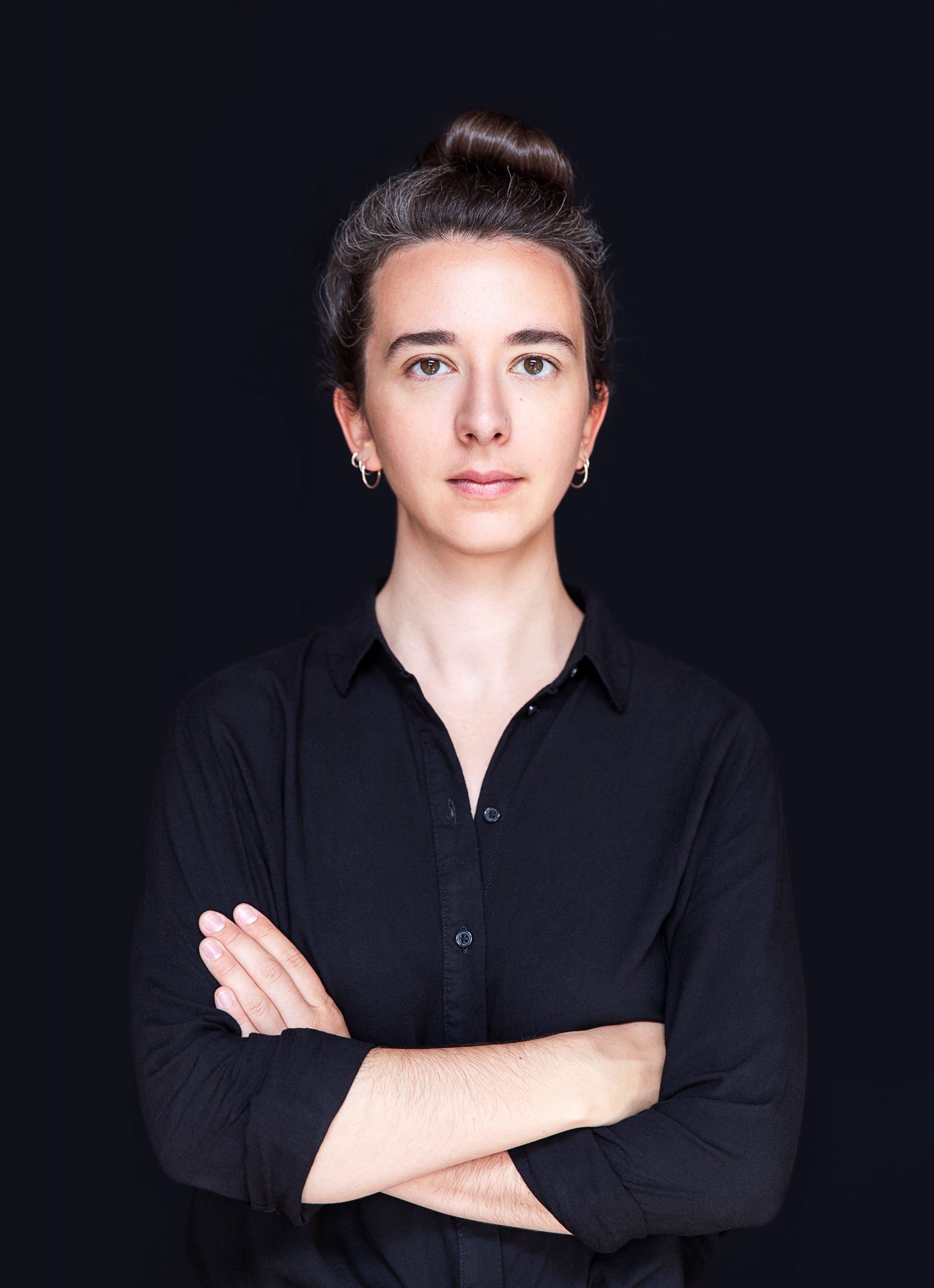
The team behind A Clean End
A Clean End is an initiative by Lucerne composer and improvisation teacher Urban Mäder; violist, composer and performer Nora Vetter; artist and scenographer Pia Matthes, who has a strong bond with sound art and Urban Mäder’s long-time collaborator Peter Allamand. Each of the four artists brought in a different perspective, says Nora Vetter in conversation. Urban Mäder has his very own language and a huge experience in this field, Pia Matthes has a good feeling for dramaturgy and, as a trained product designer, an eye for visuals, Peter Allamand knows very well how things work and takes great pleasure in trying things out and fiddling around. For example, he brought a leaf blower to a meeting of the four so that they could try out directly in the café where they met how such things sounds and works. As for herself, Nora Vetter explains that, in addition to the focus on the sound and compositional aspects which she shares with Urban Mäder, the political dimension in this work has been of great importance. Thus, she says, it was important for the actual cleaning staff to appear. As a result, fourteen of the fifteen employed cleaners were actually featured and while the musicians on stage come from all over the world and are rightly celebrated for their performances, the cleaning staff, who are often migrants, usually remain hidden. Furthermore, the cliché is attached to this occupation that the cleaners unfortunately have no other choice. “But,” says Nora Vetter, “at the end of the day, both making music and cleaning are work tasks and both are equally necessary for a festival like the LFF to happen.”
Nora Vetter: ‘Dream Paralysis’, latenz ensemble, Zürich 2021.
To be taken seriously
To be taken seriously are perhaps the keywords that can be used to summarise the various concerns behind the collective intervention A Clean End. Both the people who do the important but invisible work of cleaning and tidying up, as well as the sonic, even musical potential of the cleaning equipment are to be taken seriously.
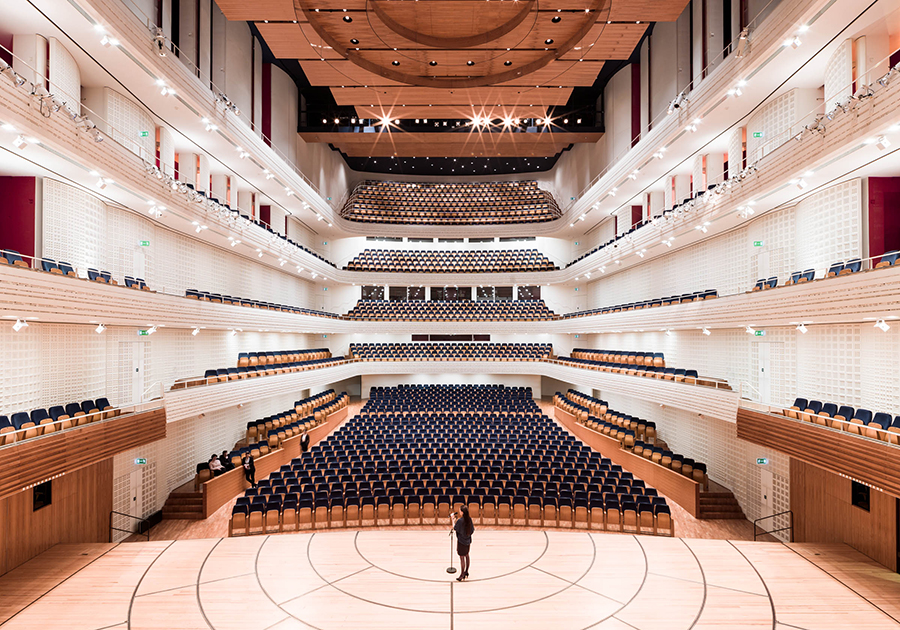
The initiative’s aim is not to put on a funny show, but to take the sonic possibilities of the cleaning activity and the cleaning equipment seriously, says Urban Mäder. Their intervention is based on a clear musical idea, which is comparable to classical compositions. “When you compose for the orchestra, over time you get to know the woodwinds, the brass, the percussion instruments and so on. Now we know about all the cleaning machines and how they sound.” And above all – the audience finally sees the people who make sure that the KKL presents itself clean, tidy and in impeccable at every concert and can thank these mostly invisible people with the applause they deserve.
Jaronas Scheurer
Trailer of the intervention “A clean End” from Urban Mäder, Nora Vetter, Peter Allamand and Pia Matthes. Lucerne Festival Forward, November 20 2022, KKL Luzern.
The Lucerne Festival Forward took place from November 18 to 20 in Lucerne.
The collective intervention was premiered at the final concert on the 20th of November in the concert hall of the KKL.
Beside Urban Mäder and Nora Vetter, Pia Matthes and Peter Allamand are part of the team behind A Clean End.
Neo-Profile:
Urban Mäder, Nora Vetter, Patricia Kopatchinskaja, Lucerne Festival Contemporary Orchestra
From Loop to Drone: Turning points by Janiv Oron
Friedemann Dupelius
There is something tidy and neat about the way vacuum-cleaning robots prance across the floor. Always on the lookout for unswept corners, they circle around, turn, jerk back and forth, left and right, orchestrating their hunt for the last speck of dust with an unrelenting hum. Last summer, Janiv Oron packed small speakers onto two of these modern household helpers. In the Istanbul art gallery Öktem Aykut, they scrubbed their way between the visitors on the parquet floor and played a mobile soundtrack, consisting of fragments of Janiv Oron’s compositions and their own constant whirring, to Renée Levi’s paintings on the walls.

It’s almost like Karlheinz Stockhausen’s Rotortisch and its rotating loudspeaker had discovered mobility after 60 years. Or else the party trucks, as we know them from Zurich’s Street Parade, had lost their way. Janiv Oron would probably be happy with either interpretation. The Basel musician and sound artist not only moves his sound sources, but also himself between different musical points, stirring up the dust of habits in the process. As part of the DJ duo Goldfinger Brothers, he has been playing at parties for over two decades. During his music and media art studies at the Bern University, he was introduced to sound art and contemporary composition. Since then, Oron has been expanding his sound language and rethinking the tools he grew up with in club culture on his new paths, working with record players and vinyl records as instruments for both composition and live performance. He also uses loudspeaker systems to sonically react to spaces and to create new sound spaces within them, guesting in galleries, but has also collaborating with contemporary music ensembles and dance companies in recent years.
In May 2022, Janiv Oron released his first solo album „Easel“ on the Zurich based label Light From Other Days. Oron recorded the pieces with Buchla’s analogue “Easel” synthesizer.
Everything rotates
The motif of rotation is conspicuous to the eyes and ears in many of Janiv Oron’s works: “The mix, infinite loops, revolutions of the mind, speed, phase shift, general forms of repetition or spatiotemporal displacement,” is how he describes his fascination with everything spinning in music. “These are swirls of sound in time and space. They create a dynamic or kinetic fullness.” Rotating loudspeakers, performing vacuum robots and spinning turntables circle through Janiv Oron’s art, which, for all its compositional abstraction, is strongly informed by the body in space and bodily perceptions: “Sound moves onto the skin and the skin starts to hear for you.” Janiv Oron knows from the club scene how it feels to be tickled in the diaphragm by subcutaneous bass frequencies.
Janiv Oron at Nachtstrom 94 (Gare du Nord, Basel)
For his concert with Basel Sinfonietta in June 2022, to close their anniversary season “40+1”, he brought a sound system – built by a friend – to the Pfaffenholz sports centre hall. The two high loudspeaker towers were necessary to record the “soundclash” with the 80 musicians strong orchestra. At the same time, it provided an adequate sound for a large sports hall. In this concert, the Sinfonietta played Flowing down too slow by Fausto Romitelli and Christophe Bertrand’s Mana. Janiv Oron sampled 64 small excerpts from these two compositions, some of them only a few seconds short, and ran them through various computer algorithms. The source material was thus stretched, distorted and taken out of its original context. “In sampling, I isolate scraps of a story and insert them into a new narrative,” he explains. In a next step, composer Oliver Waespi orchestrated 21 selected remix fragments by Janiv Oron, again for the Basel Sinfonietta. Oron finally played live on the turntables with the orchestra. The records, connected to a software, served as a control unit for the individual orchestra samples.
The title of this re-composition is Datendieb (Data Thief): “In my music I very often work with already existing material. In sampling, one becomes a time traveler. You steal in the past, edit in the moment and think the material forward into the future.”
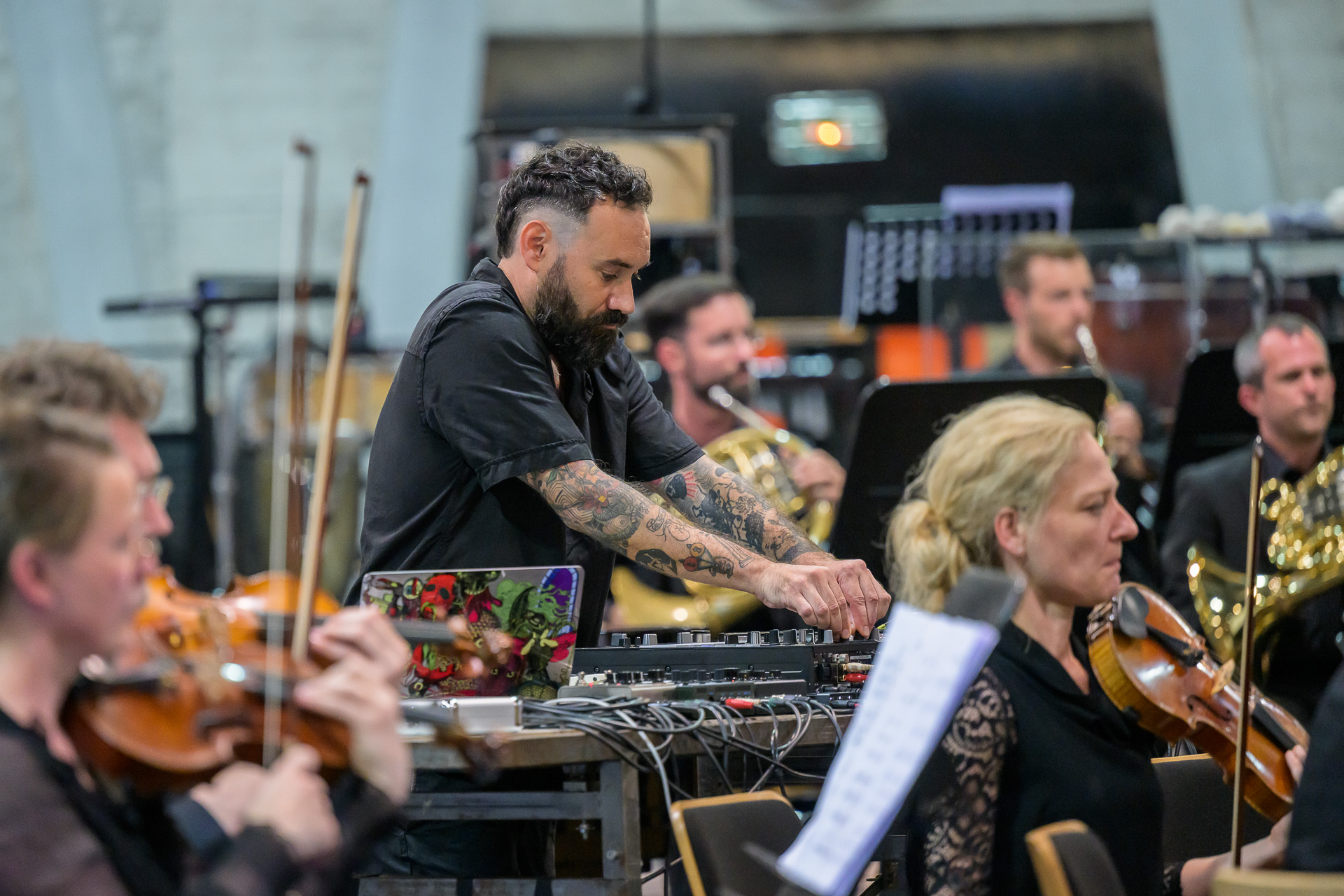
Death Can Dance
Similarly oscillating between times is the loop – the germ cell of electronic dance music (often) pressed onto records, to which Janiv Oron continues to feel connected. Over the years, he developed a fascination for what is usually referred to as drone in electronic music. Oron breathes life into his drones with analogue or digital electronic instruments and plays them in several collaborations i.e. with Christoph Dangel (cello), Stefan Preyer (double bass), Thomas Giger (light art) and the Basel Chamber Orchestra – with whom he has already realised several cross-genre projects, such as the three parts of “Don Bosco’s Garden”.
„Don Boscos Garden 1“ – with Janiv Oron, Christoph Dangel, Stefan Preyer & Thomas Giger
In the latter, realised at the end of October 2022, Oron mixed the instrumentalists of the chamber orchestra playing sporadically in the Don Bosco building into a remix of Mahler’s 4th Symphony.
https://www.youtube.com/watch?v=TBi1BK8r2UE
„Don Boscos Garden 2″ – with Kammerorchester Basel, Giulia Semenzato & Anne-May Krüger
Another collaboration is scheduled for November 2022, in which Janiv Oron and organist Filip Hrubý will compose music somewhere between ambient, organ sounds and electronics for the Basel dance company MIR. Both organs of the Predigerkirche in Basel will be used for the work entitled Now here – no where, a Totentanz for the 21st century, approaching the abstract phenomenon of death and one’s own mortality. To this end, eight amateur dancers from Basel were included in the development process as “experts of everyday life”; and one of them will dance live on stage. Even if Janiv Oron is still keeping a low profile with regard to musical details, one can assume that no definitive song of death will be played here. Because: Everything turns and comes back in a different shape.
Friedemann Dupelius
Now here – no where. Ein Totentanz für das 21. Jahrhundert
9.-20.11., Predigerkirche Basel
Janiv Oron
MIR Compagnie
Christoph Dangel
Stefan Preyer
Thomas Giger
neo-Profiles:
Basel Sinfonietta, Kammerorchester Basel, Oliver Waespi
The composer with the soldering iron
When she is not on the road presenting her music, which is played by the most important contemporary ensembles and large symphony orchestras, Lisa Streich lives with her family on the Swedish island of Gotland. She uses the most modern compositional techniques to create a universal musical language that speaks directly to the audience and captures today’s zeitgeist without being ingratiating. Annelis Berger tries to find out how she manages in a conversation.
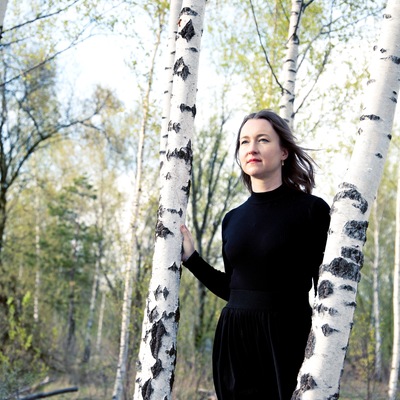
Annelis Berger
Contrasts, over and over again: sharp whip beats penetrate the ear, and in the gaps – these horrible gaps between the beats – hover strangely enraptured pianissimo chords, where one does not know whether the ear is deceiving itself or the orchestra musicians are softly singing along. One sits there amazed and immersed in a surprising musical language that somehow “makes sense”, although complex and multi-layered. Segel is the title of Lisa Streich’s piece, which premiered at the Lucerne Festival in 2018.
It is my first contact with the Swedish composer’s music. Later, I realised that this musical language is typical of Lisa Streich’s works: they surprise, and at the same time speak directly to the listener. One does not feel excluded, not even at first hearing. There is no hermetic superstructure that one first has to figure out to find access to the music, despite the fact that each of the pieces is the result of very elaborate intellectual, artistic and technical work.
In Segel from 2017, Lisa Streich used a “spectral tonality” for the first time.
Lisa Streich was born in Sweden in 1985, she trained as organist and later studied composition in Berlin, Stockholm, Salzburg, Paris and Cologne. She avoids the spotlight, the stage is not her thing. But in the gallery, alone at the organ, this “breathing creature that doesn’t belong to you and that smells different in every church”, that’s where she feels comfortable. The same goes for composing at home on the island of Gotland, which lies on the Baltic Sea between the Baltic States and Sweden and where, close to the sea and in the midst of a picturesque landscape, she alternately occupies herself with family fife and composition. This also includes tinkering, handicrafts, building devices. At some point, Lisa Streich started to incorporate electronics into her music, small machines that she builds in an old shed next to her house: She soldered, built, assembled and then, for example, in the piece Pietà for motorised cello and ensemble, created an almost mechanical sound that is so exciting precisely because it becomes universal through mechanical anonymity.
Pietà ends quietly. All of Lisa Streich’s pieces, without exception, end in piano. During the interview, she tells me that, until now, she has forbidden herself to allow loud endings; a fortissimo finale feels like plagiarism to her, like a worn out, cheap effect. Such statements are typical of the Swedish composer, who speaks perfect German. She has a high, almost moral claim to be honest with her music. That is why a statement by the Greek composer Georges Aperghis, according to which an artist must be a good liar, still concerns her today. Somehow, she can see what he means and it makes sense, but it doesn’t work for her, she says.
No, that doesn’t work for Lisa. Her music is instead distinguished by a playful spirituality, one not achieved through artifice, but through authenticity, honesty, not a moralistic sourness, but a sensual truthfulness. How she achieves this remains a secret, but, she says, she perhaps captures a certain feeling of the times with her music, which corresponds to today’s audience. Naturally, one does not have control over this. But sometimes something creeps into a work that hits the core of our time.
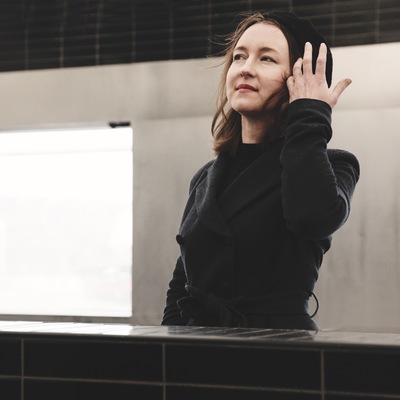
So what are the most important compositional elements that make Lisa Streich’s music so authentic, exciting and “current”?
Spectral tonality and electronic sounds
There is, for example, the so-called spectral tonality, which Lisa Streich used for the first time in the above-mentioned work “Segel”. To create such floating chords, she looks for recordings of amateur choirs, which by their very nature are not perfect. She takes chords from these intonationally not quite clean recordings and makes a spectral analysis of them. She then works with this spectrogram in order to create a microtonal or “spectral tonality”. Lisa Streich says that she loves tonal music, but that through frequent playing and listening she gradually felt nothing more about it. On the other hand, when she listens to amateur choirs that don’t have a completely clean intonation, she experiences tonality in a new way. In other words, when familiar chords are a little off, you can experience major and minor anew.
Another compositional mean in Lisa Streich’s music is electronic sounds, which she creates by attaching small devices to the instrument. This creates a very unique, soulful, mechanical atmosphere – often in contrast with sharp ensemble sounds that collide with these mechanical “Olimpia worlds” (E.T.A. Hoffmann).
Echoes of Roman polychoralism
There is also an affinity with the human voice and choral traditions that runs through Lisa Streich’s oeuvre. For example, in the wonderful work Stabat for 32 voices and four choirs, written in Rome during Streich’s stay at Villa Massimo. It is one of her longest pieces and inspired by Roman polychoral music, which, unlike the Venetian, is hardly cultivated any more, as it is very expensive to perform this 400-year-old, multi-choral music. In those days, boys sang on the balconies and even in the dome of St. Peter’s, connected to the conductor only by hatches. In the church of S. Giovanni in Laterano, for example, where the choral work was first performed, there are twelve balconies. This many-choir system was originally used to create a kind of unplugged Dolby Surround sound system, which fascinated Lisa Streich and she tried to bring this sound into the 21st century in a four-choir work. The resulting piece is a kind of meditation for choir, suggesting a vast landscape, or a timeless and spaceless level into which one can fall without landing softly nor hard. One simply IS.
32 voices distributed over four choirs can be heard in Stabat by Lisa Streich from 2017. Here she translates the 400-year-old Roman polychoral into the 21st century.
Lisa Streich answers the question about religious content of such works, which already refer to an ecclesiastical tradition from their title, hesitantly. Yes, religion used to play an important role in her life. Less so today, but it is still important. However, it is less linked to a specific religion. “I am sure that there is a world that is invisible, but stronger and bigger than our visible one. Music, too, allows us to experience or feel things that are perhaps not of this world at all.”
In fact, Streich’s music offers the possibility of spiritual openings, if one allows oneself to be drawn into it. Perhaps this is precisely what appeals in the composer’s work, not the programme, but an underlying current that one consciously or unconsciously perceives.
Annelis Berger
On Saturday, October 8, at 7:3pm, the Collegium Novum Zurich will premiere her piece OFELIA at Zurich Tonhalle.
broadcasts SRF 2 Kultur:
Musik unserer Zeit, 12.10.22, 20h / 15.10.22, 21h: Im Innern der Orgel: Lisa Streich, composer and organist, author Annelis Berger
Neo-Profiles: Lisa Streich, Collegium Novum Zürich,
100 Years IGNM – A fellowship of companions
The “International Society for New Music” was founded 100 years ago, with the aim of creating network- as well as showcase-opportunities for contemporary music from all around the world. Its Swiss section, SGNM, was launched in Winterthur the same year. It organised six of the annual “World Music days” in 2004 and contemporary music even travelled through Switzerland by train.
A portrait by Thomas Meyer.
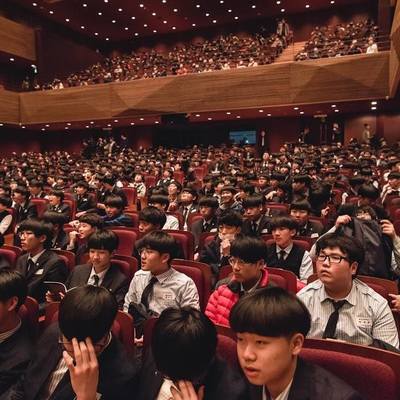
Thomas Meyer
31 years ago, in the church of Boswil, the ‘ensemble für neue musik zürich’ played an exciting programme, including works by Japanese composer Noriko Hisada and Australian composer Liza Lim. The two were not yet thirty years old and unknown in this country at the time – but they were not to remain so for long, as the ensemble was enthusiastic and gave them both several commissions over the decades. CDs were made and a long friendship developed. That concert is a beautiful example to me of what could happen at the so-called “World Music Days”.
Voodoo Child by Liza Lim (1990) – ensemble für neue musik zürich directed by Jürg Henneberger / Soprano: Sylvia Nopper, Kunsthaus Zürich 1997, © SRG/SSR
The festival took place in Zurich in 1991, gathering musicians from all over the world and on one afternoon the guests were taken to the idyllic Freiamt. These “World Music Days” thus fulfilled precisely the purpose of bringing new music from all countries together across oceans and continents, as stated by the festival’s organisers: the “International Society for Contemporary Music IGNM” or ISCM. The input came from the composers Rudolf Réti and Egon Wellesz. On 11 August 1922, an illustrious crowd met at the Café Bazar in Salzburg. Names like Béla Bartók, Paul Hindemith, Arthur Honegger, Zoltán Kodály, Darius Milhaud and Anton Webern were among those present; others had excused themselves.
The time were highly interesting, immediately after the world war had destroyed all order and nothing could be taken for granted any more. New music found itself in a changed culture. Exhausted by the war, but also by the violent scandals of 1913, it began to withdraw and organise itself. Schönberg and his circle in Vienna during the years 1918-21 with their “Verein für musikalische Privataufführungen”. Edgard Varèse founded the “International Composers’ Guild” in New York in 1921 with the aim of performing modern music. In the same year, the «Kammermusikaufführungen zur Förderung zeitgenössischer Tonkunst» were held for the first time in Donaueschingen. The name is significant, contemporary music had to do something and reform itself.
Richard Strauss was involved as president in IGNM’s founding, but soon handed the office over to English musicologist Edward Dent. Although the first impulse came from the Austrians, the British soon took over both leadership and administration. National sections came into being. As early as October, Werner Reinhart, a patron of the arts from Winterthur, Switzerland, came forward and announced a Swiss section. He had money and an interest in contemporary music, so the section took up residence at Rychenberg. In 1926, the World Music Days were held for the first time in Zurich, where, for example, Webern’s Five Orchestral Pieces op. 10 were premiered, followed by Geneva in 1929. The IGNM ship set sail and crossed the continents for its festivals.
World music festivals stand for communication and exchange between countries
The World Music Festivals are the heart of the organization, trying to do something in order to unite nations – even if only by approaches. “No music festival, no arts community would be able to prevent catastrophes like the one that broke out in 1914,” wrote Austrian music historian Paul Stefan after the Geneva festival. “But every bond has been tightened since then, and quite unlike in the past, the artists of today have become companions.” Admittedly, this degenerated into conflict again a few years later, when in 1934, on the initiative of Richard Strauss, a counter-organisation, the Nazi-affiliated “Permanent Council for the International Cooperation of Composers”, was set up to undermine the influence of the IGNM. In 1939, for example, Czechoslovak musicians were forbidden to travel to the World Music Festival in Warsaw.
All member countries propose compositions for the World Music Festivals, which are then evaluated by a jury on site and supplemented with programme ideas from local organisers. Fifty-fifty should be the ratio between the two parts. The programme is colourful and usually has no common denominator. But taking a look at the list of works, one can find many masterpieces. For example, Schoenberg’s Moses und Aron was premiered in Zurich in 1957. Some things might get lost or forgotten, but long and lasting connections are made, which is IGNM’s essence: communication and exchange between countries.
Gemini, Konzert für zwei Violinen und Orchester by Helena Winkelman, Premiere with Sinfonieorchester Basel and Ivor Bolton, violins: Patricia Kopatchinskaja / Helena Winkelman: the first woman to represent Switzerland at the World Music Days in Ljubljana in 2015, where her piece Bandes dessinées was premiered.
In 1970, the World Music Days took place in Basel, in 1991 in Zurich, and in 2004 the IGNM delegation travelled by train throughout Switzerland. This unusual idea under the title Trans-it was developed by a team around composer Mathias Steinauer, a completely new kind of impulse.
Steinschlag (1999) by Mathias Steinauer «World Music days» 2004 at Infocentro NEAT.
Those were the highlights, but in general the Swiss section, SGNM, is rather quiet and anchored in the local scene. The national society currently consists of eight regional groups. Several festivals and ensembles are also affiliated members, all organising concert series and often bringing unknown music to this country.
The national section has become significantly more active again in recent years however. Singer, performer and composer Javier Hagen has set some accents since taking over presidency in 2014.
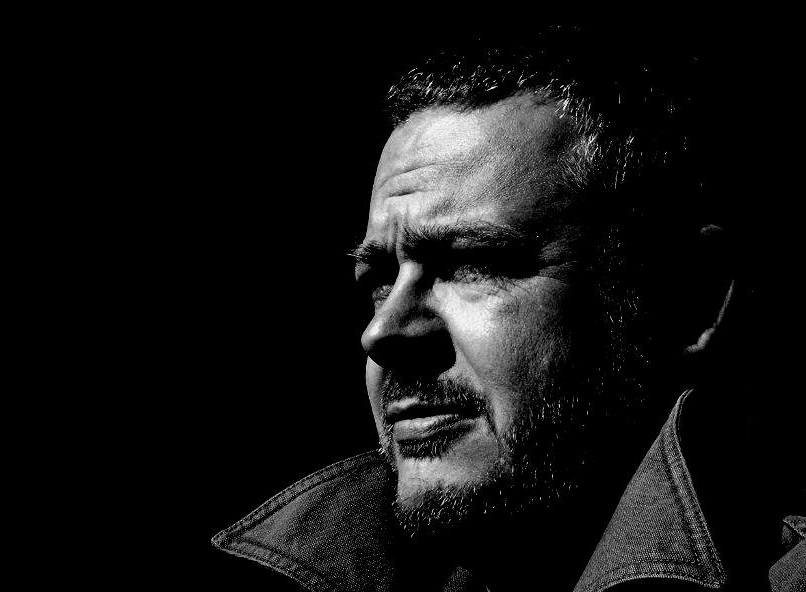
First of all, this concerns historical examination, as some things had been handed down incorrectly and had to be corrected – which was especially important in view of the centenary. Valuable correspondence on the founding period was found in Winterthur. Documentation is necessary because much has been lost and difficult to find. Fortunately, former SGNM president, Zurich critic and organist Fritz Muggler, has a rich archive.
66 IGNM sections from 44 countries
The world music festivals are also documented. Not only the past, but also the present comes alive. Even if you were to travel to the festivals every year and listen to around 120 works each time, that would still make it impossible to get an overview of what is happening in all 66 sections from 44 countries. That is why the SGNM regularly presents music from all over the world in its “Collaborative Series” online.
For the jubilee, the Swiss organised a choral competition in four categories together with the Basques, Latvians and Estonians – a sign that SGNM wants to open up to other circles. 108 compositions from 78 countries arrived, with Luc Goedert from Luxembourg and Cyrill Schürch from Switzerland winning the first prize aequo.
Cyrill Schürch, Nihil est toto – Metamorphosen for choir a capella, premiere with the Zürcher Sing-Akademie and Florian Helgath, Zurich 2018, inhouse-production SRG/SSR.
There has also been an opening inside the head association, ISCM. At Javier Hagen’s suggestion, the number of official ISCM languages – so far German, English and French – has been expanded to include Arabic, Chinese, Russian and Spanish. The world is opening up – and music with it. A sign of this is that next year the IGNM will meet for the first time in South Africa, in Johannesburg/Soweto.
Thomas Meyer
Read more about the association’s first six decades, in the exhaustive volume IGNM – The International Society for New Music by Swiss musicologist Anton Haefeli.
The SGNM homepage features many tracks as well as visuals documents.
SGNM is also committed to Swiss Music Edition (distribution of musical scores) and musinfo database, two important tools for local music and its distribution.
neo-profiles:
ISCM Switzerland, Javier Hagen, Mathias Steinauer, Helena Winkelman, Liza Lim, ensemble für neue musik zürich, Cyrill Schürch, Patricia Kopatchinskaja
Improvised Music in Geneva – The world of AMR
Geneva’s AMR association (AMR stands for “Association pour l’encouragement de la Musique improvise”) is the oldest Swiss institution for improvised music. Since it’s foundation in 1973, it has been committed not only to improvised concerts but also to offer rehearsal opportunities and lessons in improvised music. Its almost 50-year commitment is now being recognised with the Special Music Prize 2022.
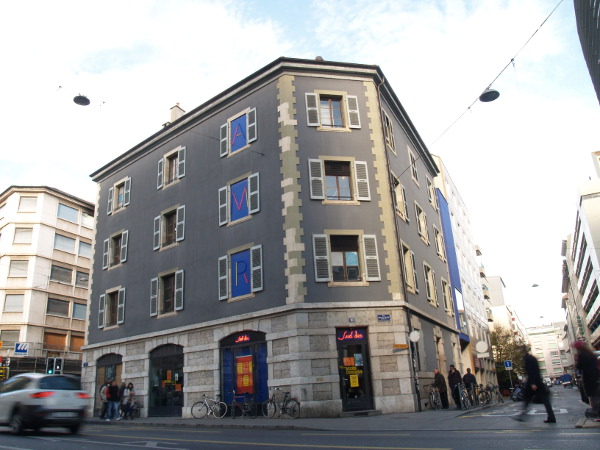
Jaronas Scheurer
Especially in niche genres like improvised music, most of the work is done on a voluntary basis. Fees for the musicians are low, the work behind the scenes is based on goodwill and the money for the organisers is generally scarce. The pandemic, during which no concerts could be held for months and general uncertainty reigned for even longer, exacerbated this deplorable situation. Not so in Geneva – where AMR managed to paid both the musicians who were booked but couldn’t perform as well as the technicians and staff who were unable to work. This is not only extremely honourable, but also quite unusual. “We had the money and we had booked them, furthermore the musicians were worse off than the organisers,” explains Brooks Giger, secretary of the AMR programme committee and double bass player.
John Menoud: Which way does the blood red river flow? Nouvel Ensemble Contemporain and the trumpeter Mazen Kerbaj, 2017. John Menoud is member of the AMR programme committee.
Milestone of Geneva’s cultural landscape
The AMR exists since 1973, almost fifty years. In the 1970s, the free jazz scene in Europe was buzzing. Peter Brötzmann, Alexander von Schlippenbach, Peter Kowald & Co. in Germany, Irène Schweizer and Pierre Favre in Switzerland. John Stevens and his “Spontaneous Music Ensemble” or the improvisation ensemble AMM in the UK, not to mention the USA with Charles Mingus, Alice and John Coltrane, Ornette Coleman, Sam Rivers, etc. The time was right for a few musicians in Geneva, who go together and devoted themselves to this musical genre.
This is how the AMR idea came about. When the association was founded in 1973, its members already knew that they wanted more than just a stage and organising concerts. “There was this great desire of the founding members to have something where they could gather, work together and create. Where they can listen to this music in concert and share it in the classroom.” – says Brooks Giger. From the beginning, AMR included also a music school as well as rehearsal rooms. The City of Geneva was receptive to this concept and soon financial support was allocated. “We were also very, very lucky that we received support from the city in the 70s and to this day,” Brooks Giger says regarding Geneva and its special situation.
In 1981, the AMR was able to rent a building on Rue des Alpes, the “Sud des Alpes”, which is still the association’s centre and headquarter. Until 2006, the “Sud des Alpes” was gradually renovated and today, it houses not only the AMR offices, but also 13 rehearsal rooms (including two large ones for ensembles) and two concert halls, one in the basement for 50 people and one on the ground floor for 120 people. In the meantime, AMR has become an integral part of the city’s cultural landscape. Brooks Giger describes it this way: “If someone in town asks where to listen to some jazz – AMR. If someone is looking for musicians for a gig – AMR.” In the meantime, they have become an institution for jazz and improvised music in Geneva, which means they still get money from the city – “on croise les doigts” (fingers crossed), says Brooks Giger.
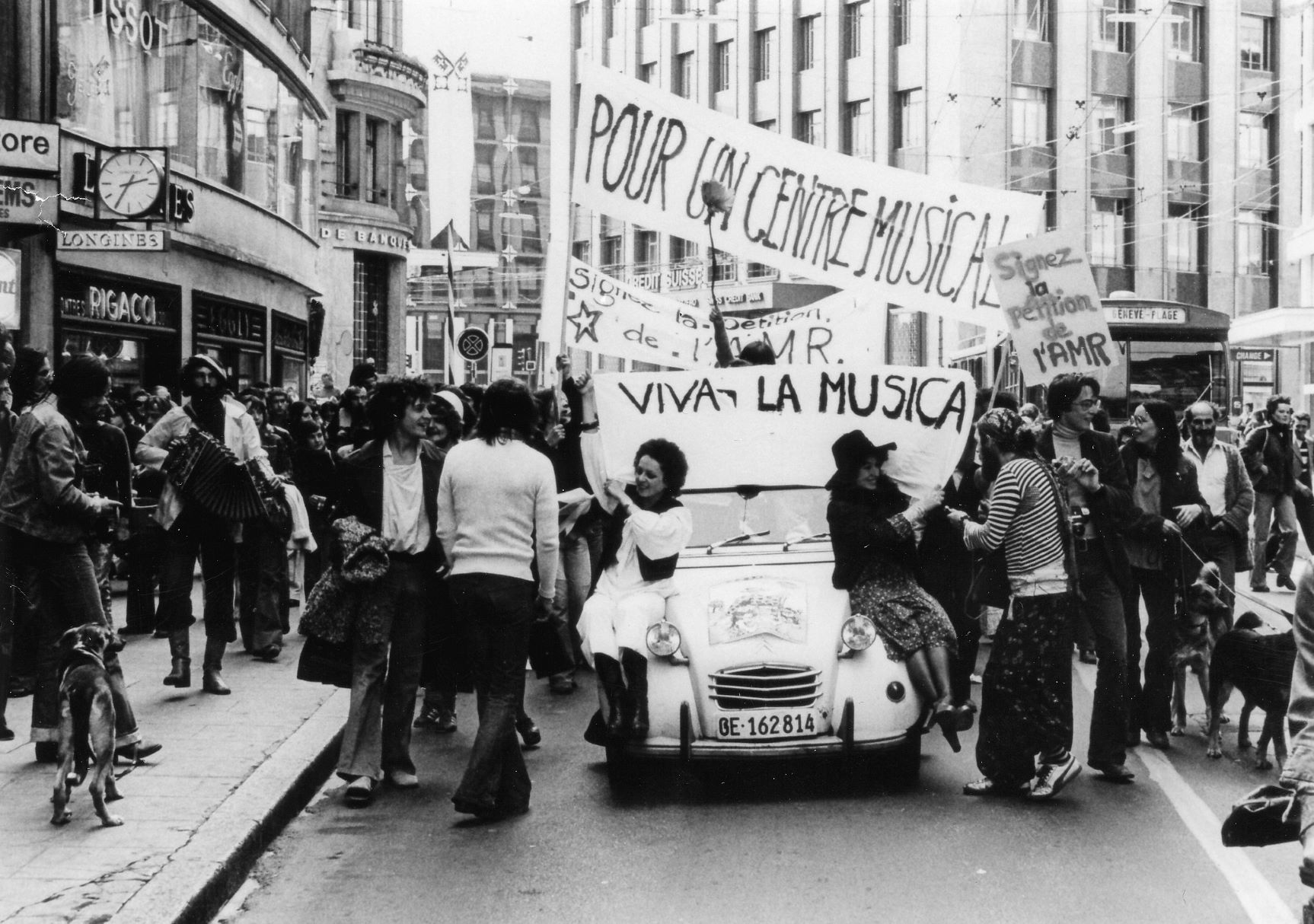
Concert programme between local scene and international stars
The City of Geneva’s financial support is tied to the condition that at least 60 per cent of the performing musicians must be from the region. The programming of the 250 to 300 annual concerts and the two festivals is therefore always balanced between local artists, national stars and international guests. The workshops held at the AMR also show what they have learned in regular concerts. So it may well be that in the same week one can enjoy the New York star saxophonist Chris Potter with his quartet, a South African-Swiss combo, a local jazz band and the AMR’s funk workshop. Fair play reigns not only through the concert programme, as the AMR staff is composed of musicians and thanks to the part-time employment at AMR, they are assured a regular income. Performing musicians who live in Switzerland can also be employed by the AMR, which ensures certain employment and welfare benefits. The ticket prices are moderate, so that everyone can afford the AMR concerts and since a few years ago, a group of members promotes gender-balanced concert programmes.
The group Noe Tavelli & The Argonauts from Geneva at the AMR Jazz Festival 2022
A Geneva gem for improvised music
In 2022, AMR is on solid fondations: it has a location with the necessary premises for lessons, concerts and rehearsals, financial support seems to be secured for the longer term, it has survived the pandemic and is again presenting a colourful, interesting concert programme. But above all, the AMR has a lively and committed music scene behind it and its commitment to improvised music has now been recognised by the Federal Office of Culture with the Special Music Prize 2022: “The association is a place of culture, equality, debate and growth,” writes the FOC on the reasons that led to the award.
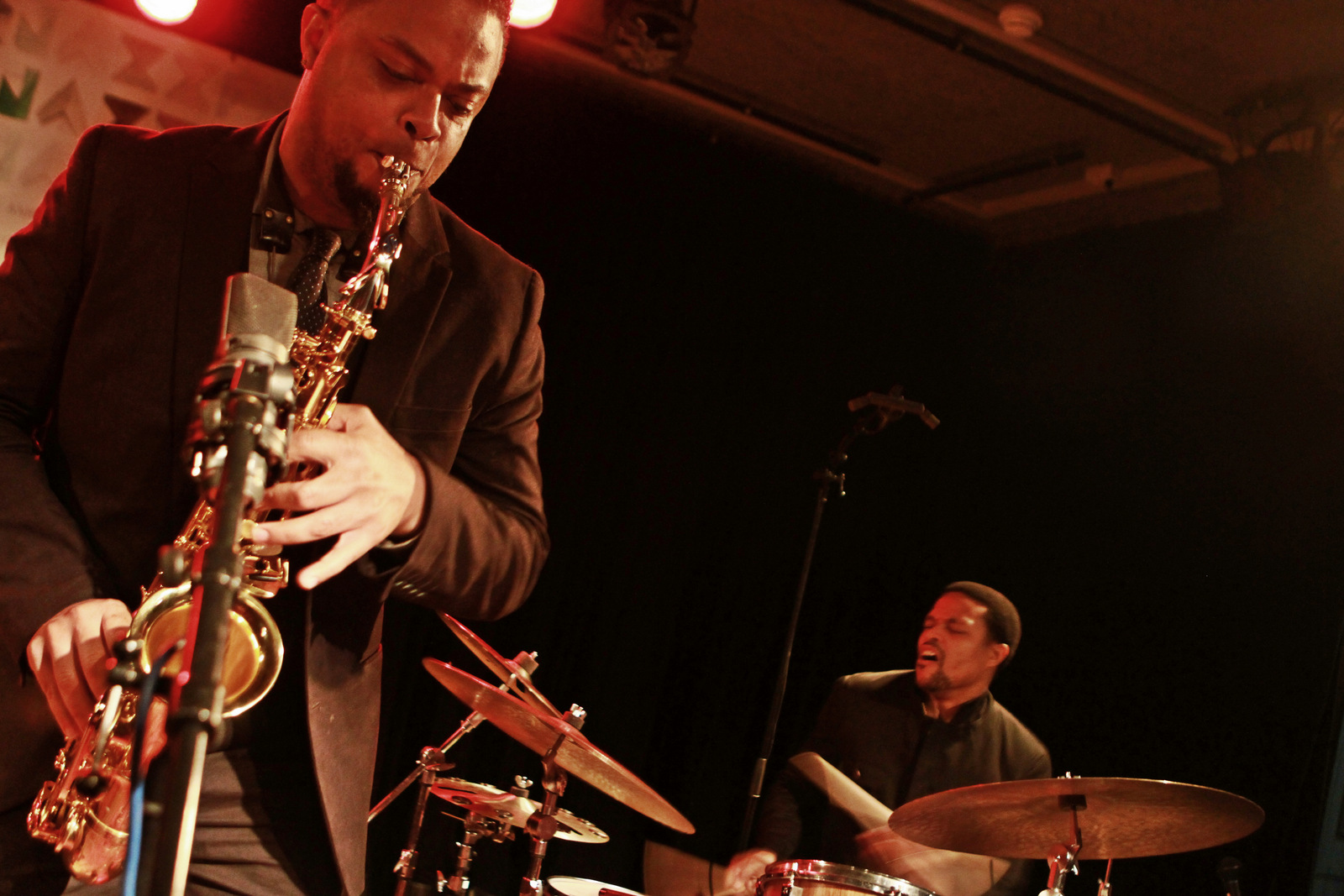
Brooks Giger, however, doesn’t see growth as a top priority. “We already do a lot with concerts, festivals, workshops and the rehearsal rooms. There is no need to do more. What we have is already a gem, a diamond. We just have to keep polishing it and taking care of it.”
Next year, AMR will turn 50. There will of course be some special events, such as a photo exhibition at Bains de Pâquis and a publication with photos and essays. Furthermore, a documentary about the AMR is currently in the making and last but not least, there will of course be plenty of good, improvised music from Geneva, Switzerland and from all over the world at “Sud des Alpes”.
Jaronas Scheurer
The website of the AMR and its concert programme.
The laudation of the jury of the Special Music Prize 2022 for the AMR.
The YouTube channel of the AMR.
Neo-Profile:
John Menoud, d’incise, Alexander Babel, Daniel Zea


